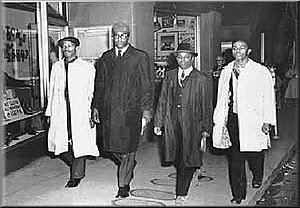The Greensboro sit-ins, which took place on February 1, 1960, marked a significant turning point in the American Civil Rights Movement. It all began when four African American students from North Carolina Agricultural and Technical State University decided to take a stand against racial segregation by sitting at a segregated Woolworth’s lunch counter in Greensboro, North Carolina. Their simple act of requesting service, which was denied due to their race, ignited a powerful movement that spread across the nation.
The four students, Ezell Blair Jr., Franklin McCain, Joseph McNeil, and David Richmond, were met with hostility and resistance as they peacefully protested against the discriminatory policies that were prevalent during that era. Despite the adversity they faced, they remained seated at the lunch counter, determined to challenge the deeply ingrained racial segregation that existed in public spaces.
Their nonviolent direct action did not go unnoticed. News of the sit-ins quickly spread, capturing the attention of the media and inspiring others to join the cause. The sit-ins became a symbol of the power of peaceful protest and a catalyst for change in the fight against racial segregation.
The impact of the Greensboro sit-ins was profound. It led to a wave of similar protests across the United States, with students and activists staging sit-ins at segregated lunch counters, restaurants, and other public establishments. These acts of civil disobedience aimed to challenge the unjust policies that denied African Americans their basic rights and dignity.
One of the key factors that made the Greensboro sit-ins so influential was the students’ commitment to nonviolence. They adhered to the principles of Martin Luther King Jr.’s philosophy of peaceful resistance, which emphasized the power of love and understanding in overcoming injustice. Their peaceful demeanor in the face of hostility helped to garner sympathy and support from the general public, further amplifying the message of their cause.
The sit-ins also highlighted the role of young people in the Civil Rights Movement. The students involved were not seasoned activists but rather ordinary individuals who felt compelled to take action. Their courage and determination inspired a generation of young people to stand up against injustice and fight for equality.
As the sit-ins continued, the pressure on businesses and local authorities to desegregate grew. Many establishments eventually gave in to the demands of the protesters, realizing the futility of maintaining discriminatory policies in the face of mounting public outrage.
The success of the sit-ins in Greensboro and other cities led to significant changes in the legal landscape of the United States. The Civil Rights Act of 1964, which prohibited discrimination based on race, color, religion, sex, or national origin, was a direct result of the efforts and sacrifices made by those involved in the sit-ins and other civil rights protests.
The Greensboro sit-ins serve as a reminder of the power of ordinary individuals to effect change through peaceful means. They demonstrated that collective action, rooted in the principles of justice and equality, can dismantle even the most entrenched systems of discrimination.
Today, the Woolworth’s building in Greensboro, where the sit-ins took place, is home to the International Civil Rights Center and Museum. It stands as a testament to the bravery and resilience of those who fought for equality during that pivotal moment in history.
In conclusion, the Greensboro sit-ins of 1960 were a defining moment in the American Civil Rights Movement. The actions of four brave students sparked a nationwide movement against racial segregation, proving that peaceful protest could bring about significant social change. The legacy of the sit-ins lives on, reminding us of the power of unity, perseverance, and the unwavering pursuit of justice.
SEO Excerpt: The Greensboro sit-ins of 1960 marked a pivotal moment in the Civil Rights Movement, inspiring a wave of peaceful protests against racial segregation. Learn about the impact of this historic event and its role in shaping the fight for equality in America.

